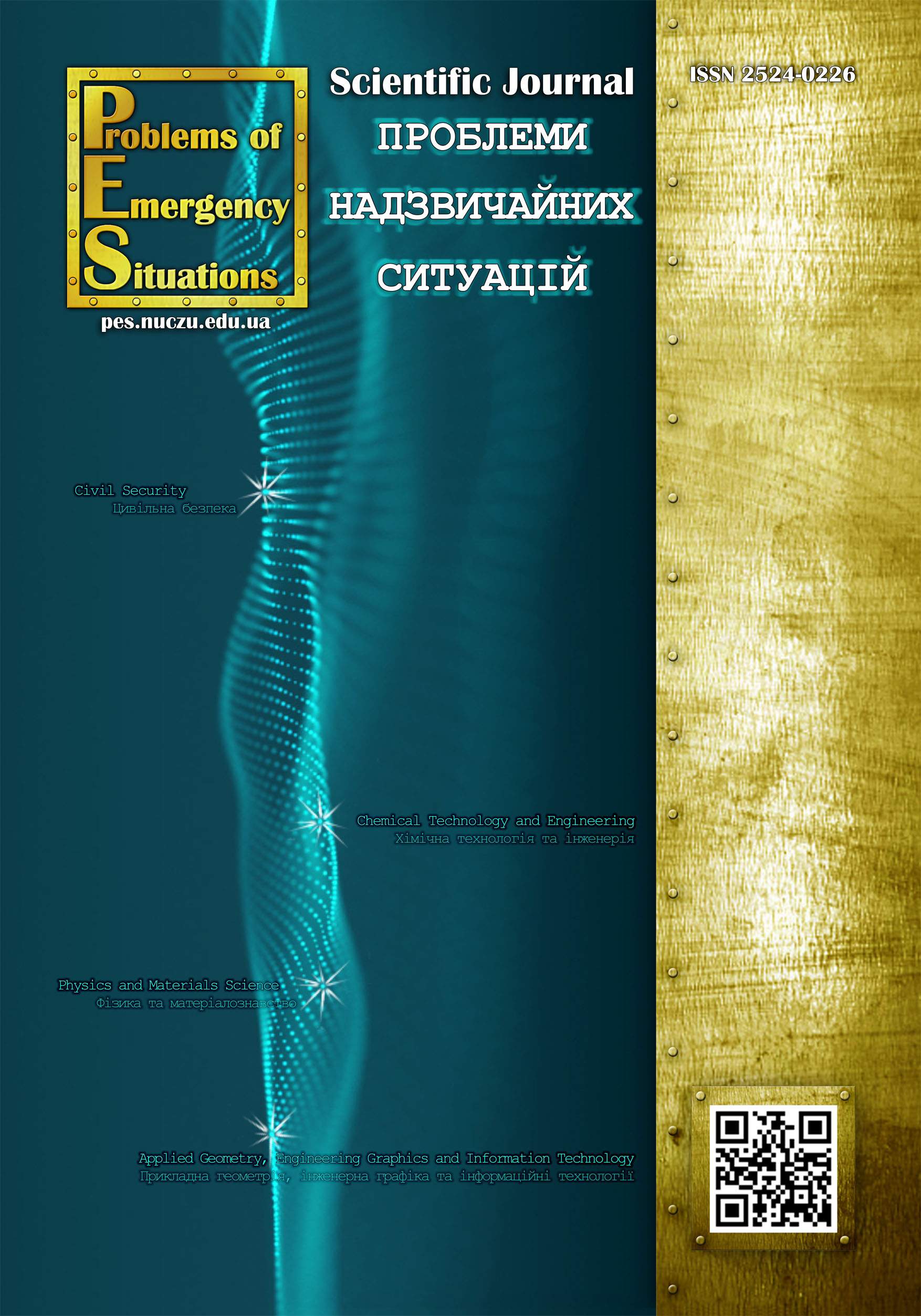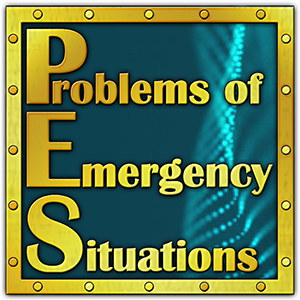Temperature distribution patterns of a steel beam with fire protection from gypsum board during fire
Zaika Nataliia
National University of Civil Protection of Ukraine
http://orcid.org/0000-0002-8757-5709
DOI: https://doi.org/10.52363/2524-0226-2024-40-2
Keywords: modeling, standard fire temperature regime, specific heat capacity, thermal conductivity, fire protection, plasterboard
Аnnotation
The article examines the temperature distribution in steel beams from the HEB 200 profile with fire protection in the form of plasterboard plates under the influence of the standard fire temperature regime. The calculation was carried out in the ANSYS WB software package to determine the dependence of the temperature in the steel structure on the time of exposure to fire. The model allows for a detailed assessment of heat transfer in materials with different thermophysical characteristics, in particular, variable heat capacity and thermal conductivity of steel and plasterboard. The use of plasterboard as a fire-resistant coating is justified by its ability to slow down the heating of steel. This approach makes it possible to significantly increase the fire resistance of steel structures while maintaining their mechanical integrity. The obtained results showed that the maximum temperature in a steel beam with plasterboard fire protection does not exceed 443 °С even with a duration of fire exposure of 60 minutes, which assumes compliance with the fire resistance class R60. The constructed graph of the dependence of the maximum temperature on the time of exposure to fire confirmed the effectiveness of fire protection with plasterboard and the high accuracy of the approximation of the model (the coefficient of de-termination R²=0.9923), which indicates the reliability of the results. The proposed model and approach can be used to assess the fire resistance of other steel structural elements, in particular, to select optimal fire-resistant materials. The research is relevant in the context of the development of cost-effective and effective methods of protecting building structures from the effects of high fire temperatures. The method of modeling fire protection in steel beams provides an opportunity to determine the temperature regimes that occur in real fire conditions, and to develop recommendations for increasing the fire resistance of steel structures, especially in modern buildings, where the optimization of material and resource costs is important.
References
- Borsuk, O., Nuyanzin, O., Kryshtal, V., Vedula, S., Horovenko, M. (2020). Study of the limit of fire resistance of a steel beam under the condition of loss of integrity of the fire-resistant coating. Emergency situations: prevention and elimination, 4(2), 5–15. Available at: https://fire-journal.ck.ua/index.php/fire/article/view/62
- Pozdieiev, S., Zmaha, M., Nedilko, I., Zmaha, Y. (2020). Methods of mathematical modeling of the area carbonation of wooden beams with lining of fire protective plywood. Collection of Scientific Papers of Cherkasy Institute of Fire Safety named after Chornobyl Heroes of National University of Civil Protection of Ukraine «Emergency Situations: Prevention and Liquidation», 4(2), 97–105. doi: 10.31731/2524-2636.2020.4.2.-97-105
- Zmaha, M. (2021). Analysis of research methods for determining the fire of wooden beams with lining of fire protective plywood. Collection of Scientific Papers of Cherkasy Institute of Fire Safety named after Chornobyl Heroes of National University of Civil Protection of Ukraine «Emergency Situations: Prevention and Liquidation», 5(2), 125–135. doi: 10.31731/2524.2636.2021.5.2.-125-135
- Franssen, J., Gernay, T. (2017). Modeling structures in fire with SAFIR®: Theoretical background and capabilities. Journal of Structural Fire Engineering, 8(3), 300–323. doi: 10.1108/JSFE-07-2016-0010
- Kovalev, A., Purdenko, R., Otrosh, Yu., Tomenko, V., Kachkar, E., Maiboroda, (2022). Evaluation of fire resistance of fire-resistant steel beams. NEWS of the Donetsk Mining Institute, 2(51), 43–53. doi: 10.31474/1999-981X-2022-2-43-53
- DSTU-NB EN 1993-1-1:2010 Eurocode 3. Design of steel structures. Part 1-1. General rules and regulations for buildings (EN 1993-1-1:2005/A1:2014, IDT). [Effective from 01.03.2013]. Ministry of Regional Development and Construction, 150.
- DSTU-NB EN 1993-1-2:2010 Eurocode 3. Design of steel structures. Part 1-2. General provisions. Calculation of structures for fire resistance (EN 1993-1-2:2005, IDT). [Effective from 01.03.2013]. Ministry of Regional Development and Construction, 98.
- Novak, S., Drizhd, V., Dobrostan, O. (2021). Evaluation of fire-resistant properties of coatings and facings for steel structures. Scientific bulletin: Civil protection and fire safety, 2(12), 43–53. doi: 10.33269/nvcz.2021.2(12).43-53
- Buchanan, A. (2021). Structural design for fire safety. Corus Construction and Industrial. Fire resistance of steel-framed buildings, North Lincolnshire, 221.
- Pallares-Muñoz, M., Paya-Zaforteza, I., Hospitaler, A. (2021). New methodology using beam elements for the analysis of steel frames subjected to non-uniform temperatures due to fires, Structures, 31, 462–483. doi: 1016/j.istruc.2021.02.008
- Sidnei, S., Myroshnyk, O., Kovalov, A., Veselivskyi, R., Hryhorenko, K., Shnal, T., Matsyk, I. (2024). Identifying the evolution of through cracks in iron-reinforced hollow slabs under the influence of a standard fire temperature mode. Eastern-European Journal of Enterprise Technologies, 4(7(130)), 70–77. doi: 15587/1729-4061.2024.310520
- Sidnei, S. O., Nuianzin, O. M., Kostenko, T. V., Berezovskyi, A. I., Wąsik, (2023). A Method of Evaluating the Destruction of a Reinforced Concrete Hollow Core Slab for Ensuring Fire Resistance. Journal of Engineering Sciences, Ukraine, 10(2), D1–D7. doi: 10.21272/jes.2023.10(2).d1
- Dovbysh, A. (2006). Justification of the conditions for the use of plasterboard boards as fire-resistant finishing materials of building structures: thesis. PhD. technical Sciences: 21.06.02. Ukrainian Research Institute of Fire Safety, Kyiv, 204.
- Sydney, S. O. (2024). Study of the influence of the finite-element grid on the temperature distribution over a hollow plate during fire simulation. Scientific bulletin: Civil protection and fire safety, 1(17), 93–102. doi: 10.33269/nvcz.2024.1(17).93-103














